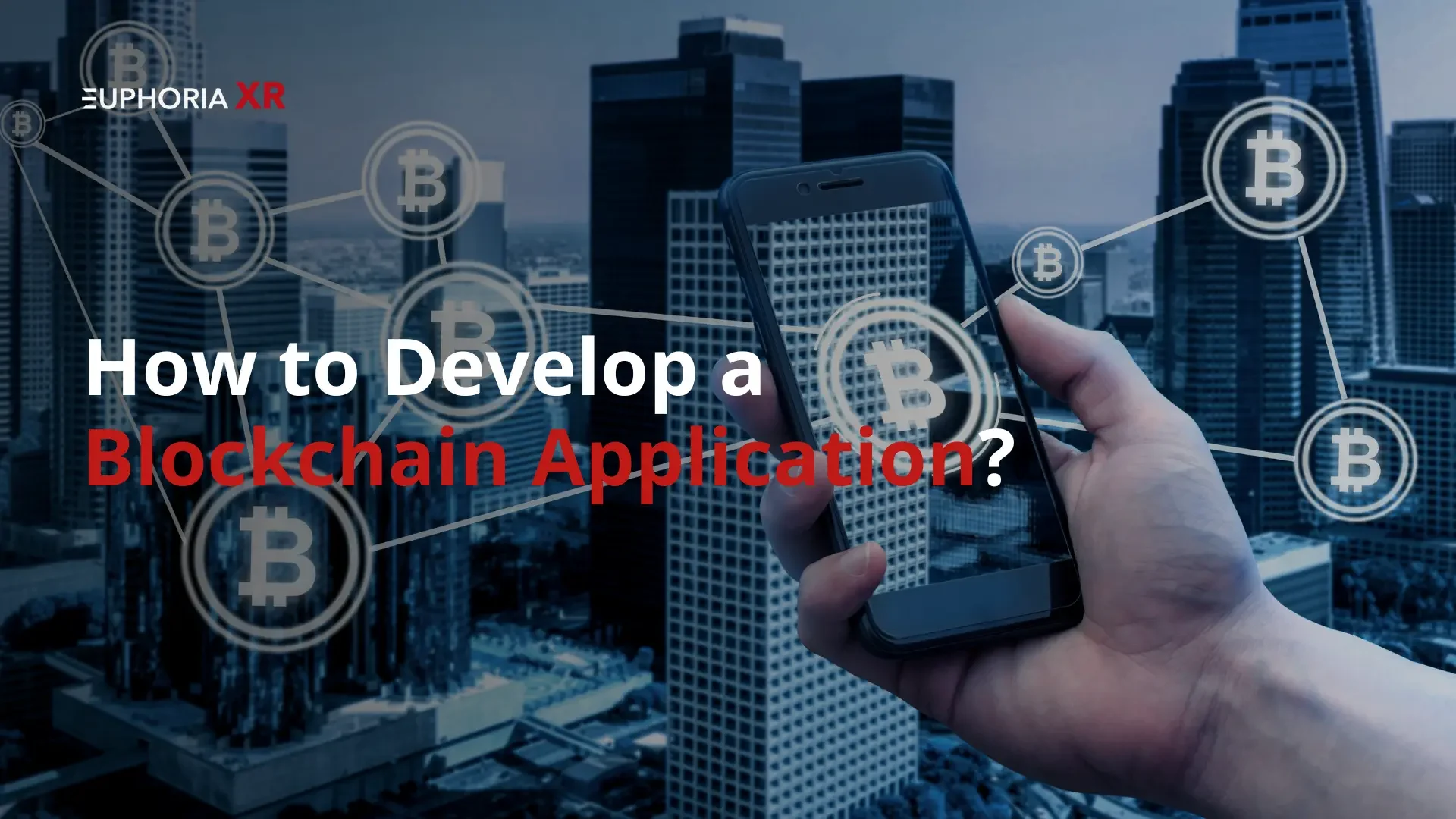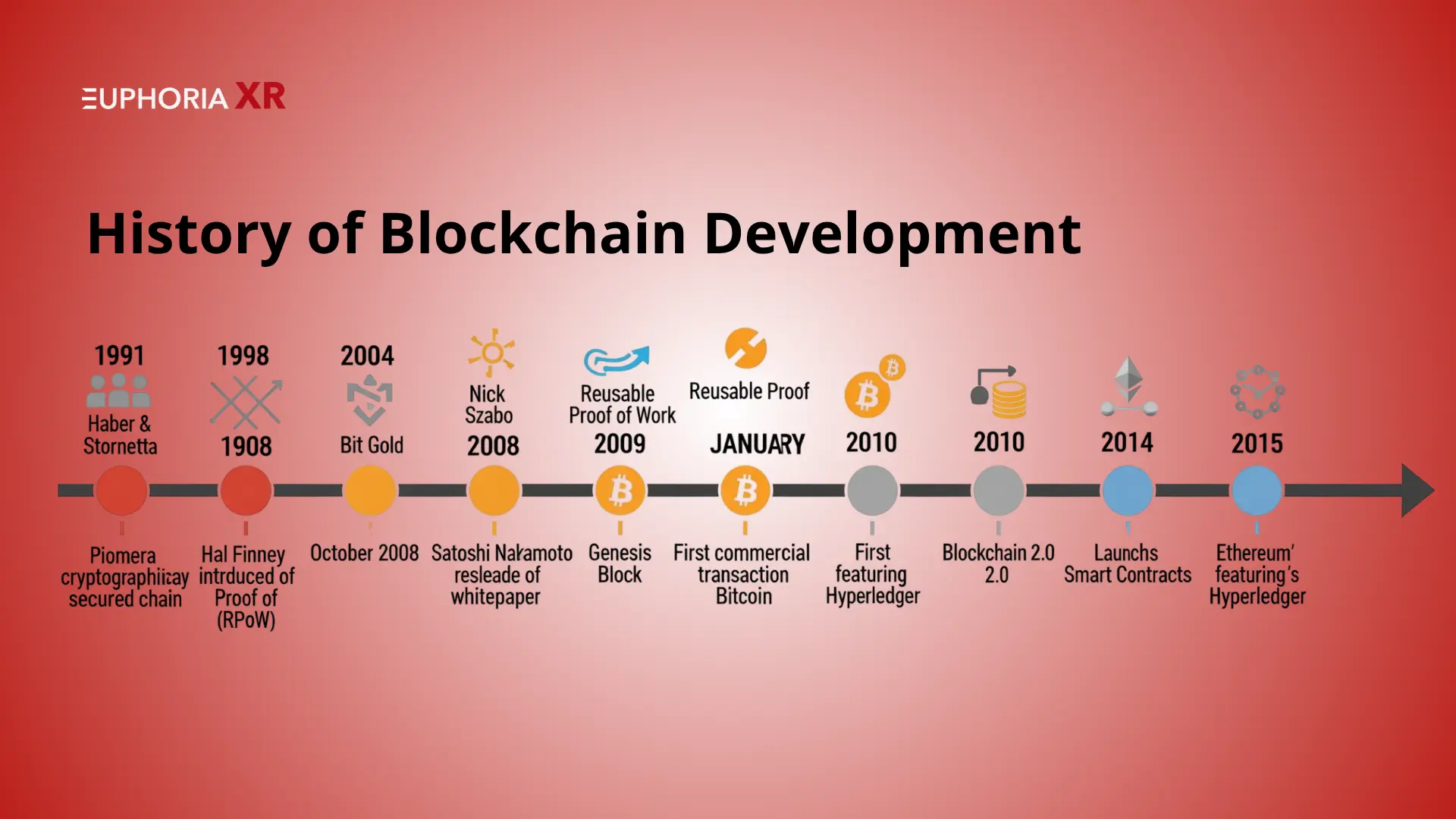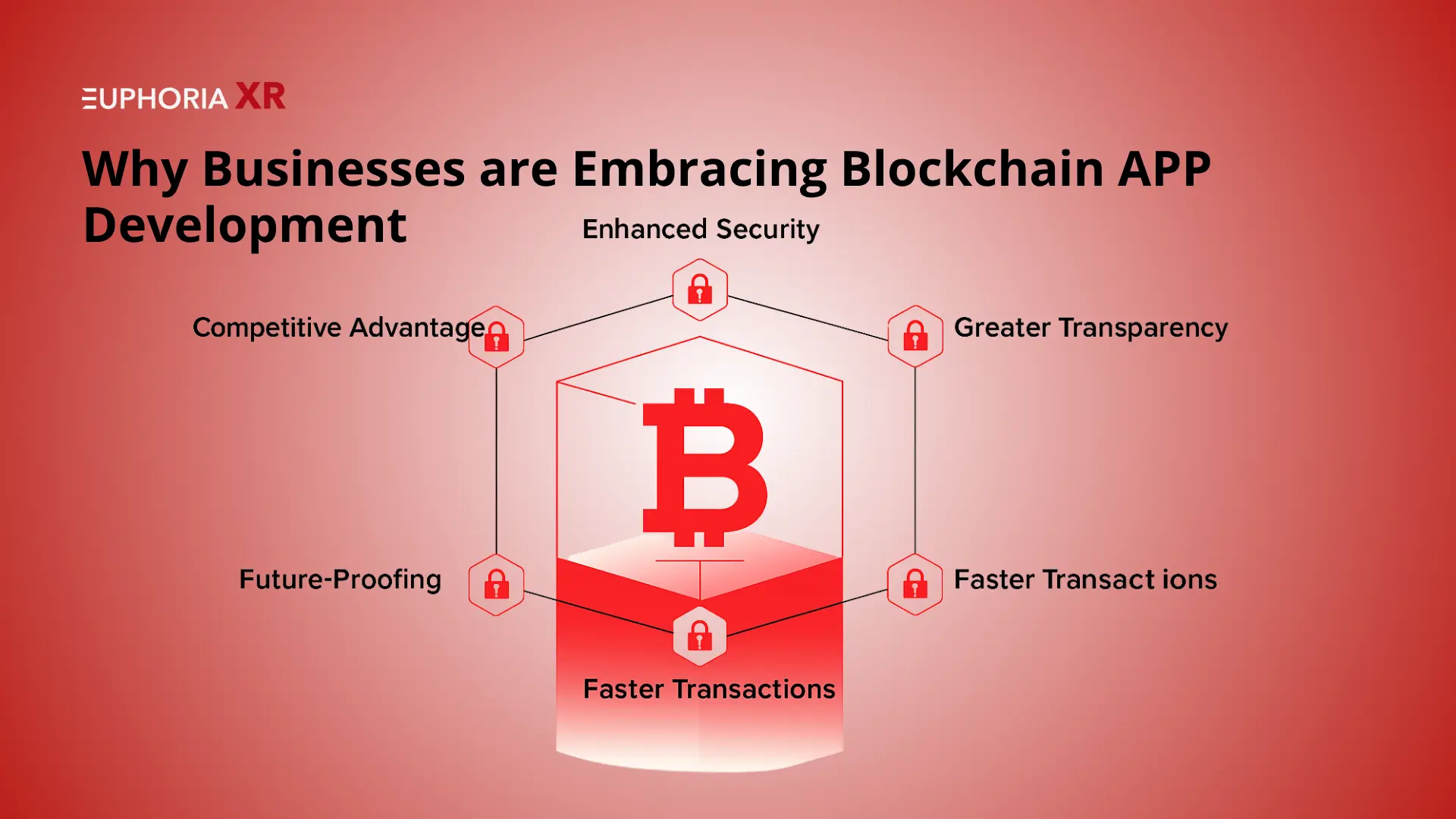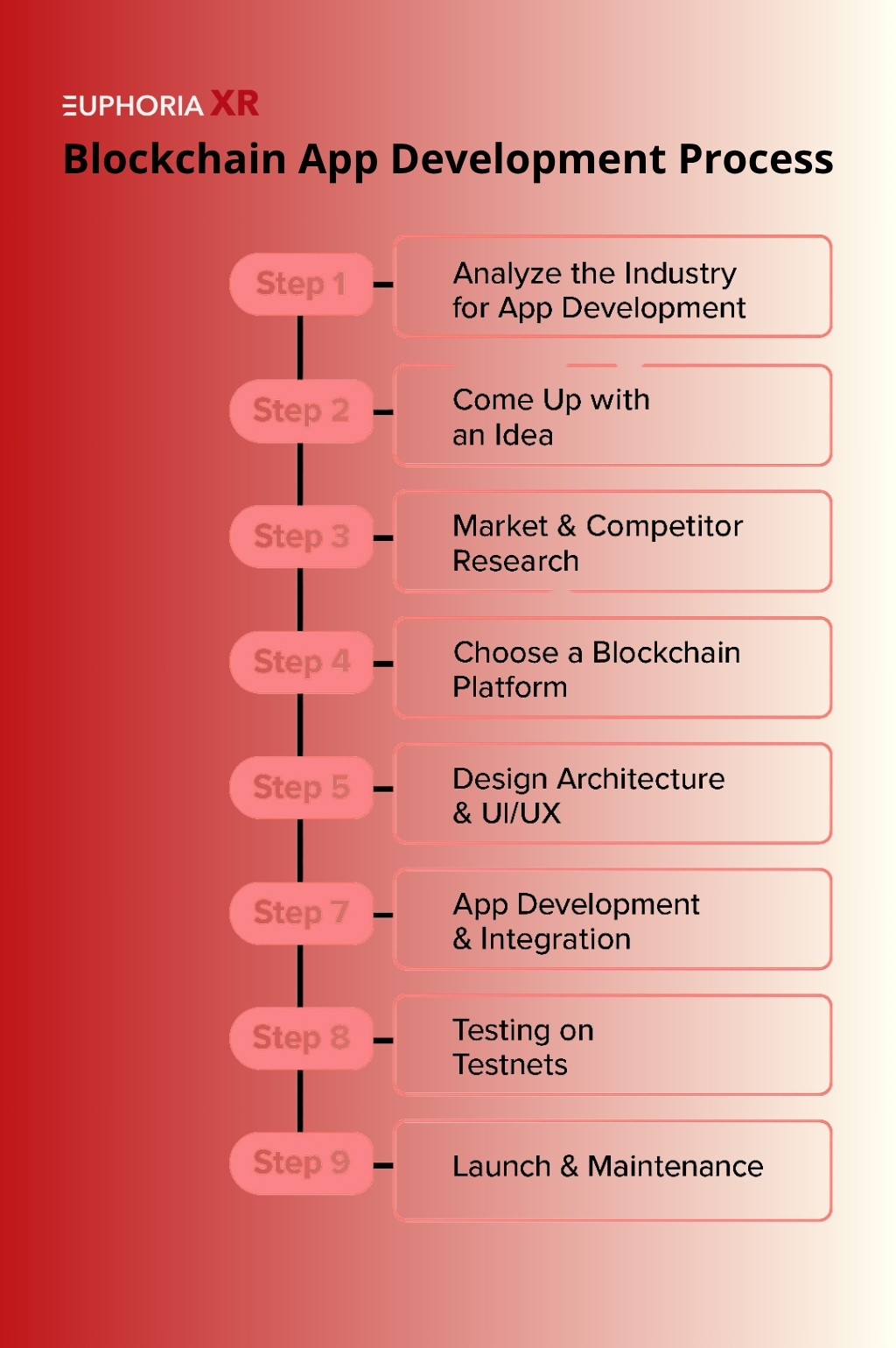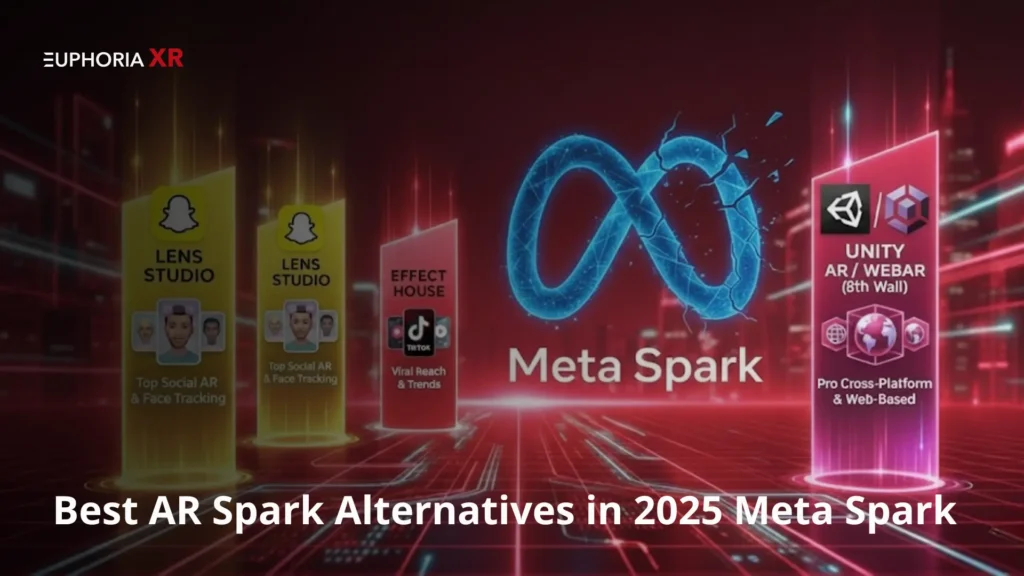Ever thought that everywhere there is blockchain, and yet you still do not know how you can practically use it in your business?
You are not the only one who is confused, and that misunderstanding is driving away business opportunities.People have been talking about decentralization, crypto, NFTs, smart contracts, etc., but when it comes to blockchain app development, most business owners are put on hold.
Is blockchain for Bitcoin only?
Is developing an app madly expensive?
And what about the investment you make, and it is not even useful in your industry?
The real truth is that blockchain for tech startups and crypto bros alike is old news. Companies in healthcare, logistics, and so on apply it to reduce expenses, enhance trust, and enjoy a serious competitive advantage.
But it can only work when you know how to construct with it.
This blog post shows how to build blockchain apps step-by-step, in simple language, with practical applications and practical advice so you can know whether it is right for you, and how to make it come true (without wasting your time or money).
Are you ready to unveil blockchain? Let’s go.
What is Blockchain App Development?
Blockchain app development is the act of creating online applications on a blockchain, an open, distributed system that stores transactions safely and transparently.
Blockchain apps (also known as dApps, or decentralized applications) do not keep information in a central server like ordinary apps; instead, the data is divided among a number of computers. This will render them:
More difficult to crack.
In confirmation, more readily proved.
When it comes to being more trusted, the users prefer it.
Such applications are capable of handling things such as digital money (crypto wallets), supply chain, automating legal contracts (smart contracts), and even secure voting.
Blockchain app development might be a potent idea to consider when you require a more secure, transparent, and automated business.
History & Evolution of Blockchain Technology
To take it back a notch and discuss the key breakthroughs that led to the present blockchain apps:
1991: Cryptographers Stuart Haber and W. Scott Stornetta proposed a cryptographically secure timestamping scheme, which was the first important step towards blockchain technology.
1998: Nick Szabo came up with a proposal to construct a digital chain using the concepts of proof-of-work and time-stamps, named Bit Gold, the first pillar of blockchain design that was used.
2008: An Anonymous Satoshi Nakamoto published the Bitcoin whitepaper, introducing a decentralized ledger technology so that it was possible to conduct peer-to-peer digital money.
2009: The first live blockchain system on the Bitcoin Genesis block was launched
2015: Ethereum was introduced, which implemented smart contracts that allowed developers to create entire applications to run on blockchain-based applications, currently referred to as dApps.
2020s: Blockchain was widely adopted in fields such as healthcare, supply chain, gaming, and identity systems.
According to Deloitte, 96 percent of top financial services innovators believe that blockchain will go mainstream, and almost 90 percent hold that blockchain is scalable to day-to-day use.
The development of blockchain quickly grew to be one of the most effective platforms for creating secure, transparent, automated programs, both in terms of academic theory and application within the industry.
Blockchain App Market Overview
Blockchain Adoption Stats
77 percent of executives think that not investing in blockchain puts their business at a disadvantageous position.
Almost 60 percent of the top executives report that they are influenced by their blockchain strategies by the issue of cybersecurity concerns.
By early 2024, more than 6,000 companies had made buying their products and services available using Bitcoin as payment.
Blockchain Trends
Permissioned and hybrid blockchains are moving fast into the world of enterprise applications.
The sectors such as finance, healthcare, and government industries are adopting blockchain to promote transparency and automation.
Deloitte estimates that by 2035, $4 trillion in real estate assets might be tokenized, demonstrating the rise in tokenization.
Market Growth Forecast
By 2030, the market value of blockchain technology may reach up to 1.43 trillion, with a CAGR of 90% by 2024, and the current value of the blockchain technology market is 31.3 billion.
Another projection forecasts an increase of this segment to 2029, with economies rising to 248.9 billion in 2029 with a CAGR of 65 percent.
One of the third reports forecasts that the market will be broader, fetching $403 billion in 2030, at a 68% CAGR.
Contacting a professional? Find a leading Blockchain Development Company to develop your idea and make it a safe and scalable application.
Why Businesses Should Invest in Blockchain App Development?
You have likely heard that blockchain is something that is considered to be safe or transparent, but what does this mean to your business?
Now, let us explore the actual, physical, concrete justifications of why the investment into the development of blockchain apps is a viable enterprise in 2025 and yet to come.
Enhanced Security
Blockchain has a distributed network where information is stored through complex cryptography. Any record added to the record cannot be changed or removed without the agreement of the network. This works well in eliminating the chance of data tampering and fraud.
IBM predicts that blockchain mitigates the risks of data breaches by more than 50 percent in such sectors as healthcare and finance.
Source: IBM Blockchain Security
Greater Transparency
All operations in the blockchain are marked with time and can be seen by authorized members. This brings about traceability, auditability, and accountability of the system. This type of transparency is useful to businesses that involve logistical processes, law abidance, or the maintenance of public records.
Faster Transactions
The blockchain apps can enforce rules automatically through the use of smart contracts, getting rid of the paperwork, manual verifications, and the involvement of a third party. In industries such as real estate or the financial industry, this can reduce processing to a few minutes.
According to the World Economic Forum, cross-border transaction times, which are currently in 35 business days, would be minimized to a few seconds using blockchain.
Lower Operational Costs
Businesses that eliminate the middlemen and minimize the input of humans can enjoy core workflow automation and cut overhead. It allows lean operations, in terms of contract checking as well as inventory tracking.
Competitive Advantage
Blockchain is being developed in most sectors. With the help of early adopters, it is possible to establish consumer trust, distinguish the brand, and experiment with new models, such as tokenized rewards or digital ownership, yet unused by the competition.
Future-Proofing
Blockchain belongs to the Web3, digital identity, and AI automation base tech stack. Early investments enable businesses to be in a position to grow as the customers change their expectations, and the rules change too.
By 2030, Gartner estimates that no less than 20 percent of the world’s economic infrastructure will have been built on blockchain technology.
Step-by-Step Guide to Blockchain App Development
Creating a blockchain application is not only a body of knowledge; it is a solution to the problem in the real world, using a secure, transparent, and future-proof technology. This is a full roadmap to guide you through the process, telling you how to go from idea to live product.
Step 1: Define Business Goals & Use Case
Before you can get technical, tell yourself why you need a blockchain app. What is your solution to? Who is going to use it? What will it do to enhance your existing process?
Select a use case that will demand trust, transparency, or decentralization. For example:
A Supply Chain application that monitors the products throughout the factory to the shelf chain.
A real estate application for digital records of property.
A health application that secures patient information.
Every other decision of the development process is in line with your use case.
Step 2: Market & Competitor Research
See what has already been done. Are there apps in blockchain that work out such issues? On which channels do they interact? What can be lacking in their strategy?
The competitor research can assist you:
Do not reinvent the wheel.
Discover niches that you can fill.
Convince yourself of what your audience anticipated.
Early insights with the help of tools such as Crunchbase, ProductHunt, and blockchain-specific directories such as DappRadar.
Step 3: Choose a Blockchain Platform
Various platforms are used to serve various needs. You would do this because of:
Scalability
Speed
Cost
Ecosystem support
The favorites are:
Ethereum: The most popular platform for decentralized applications and smart contracts.
Polygon: Lower transaction costs and quicker transactions run on Ethereum.
Hyperledger fabric: Fits in well when there are permissioned solutions that are needed privately in an enterprise.
Solana: Fast transactions, it is appropriate to use in games and real-time applications.
Select a platform that suits your business interests, and not one that is in the current vogue.
Step 4: Design Architecture & UI/UX
Great blockchain applications are invisible in their vastness, yet pleasing and non-obtrusive to the user. Architecture and interface design are a part of that.
Think about:
The way people will use your app (phone, desktop, or both)
The wallets/tokens integration: How wallets or tokens will integrate
Which app functionalities have to be on-chain vs off-chain?
Collaborate with creatives/designers who are aware of the blockchain UX patterns, as generally, the usual UI patterns do not apply in the same way.
Step 5: Develop Smart Contracts
Most blockchain applications have at their head the smart contracts. They are rules that execute themselves and automate some processes, such as verifying a transaction, authorizing access to a feature.
They have to be:
Organized and effective (nonetheless, to prevent enormous gas prices)
Proven thoroughly (against exploits)
Undergoing an audit when dealing with money or confidential information
Programming languages: Solidity (Ethereum, Polygon, or Rust (Solana).
Step 6: App Development & Integration
It is the front-end and back-end teams’ convergence point. These are some common procedures:
Choosing to attach your app to the blockchain through API, represented by Web3.js or Ethers.js
Incorporating wallets of cryptocurrencies (such as MetaMask)
Designing dashboards, logic, and user flows
Installation of cloud services or distributed storage (e.g., IPFS)
Blockchain development is not unique, but rather a combination of decentralized technology and regular development of applications.
Step 7: Testing on Testnets
Before you run live, you need to test in a secure, test blockchain environment. Such are known as testnets.
For example:
Ethereum Goerli or Sepolia
Polygon in Mumbai
Testnets help:
Test smart contract logic
Monitor interaction between users
Make sure there are no bugs or vulnerabilities
Perform automated testing and the walk-through. Do not miss this step.
Step 8: Launch & Maintenance
After performing tests, you will be able to move your smart contracts into the mainnet, which is the live blockchain network. However, your job is not done there.
Post-launch includes:
Gas monitoring prices and performance
Modernization of front-end characteristics
Reaction to customer feedback
Processing and uptime maintenance, and reacting to blockchain protocol changes
You want a partner that can help you long term; there is more than a handoff.
Step 9: Promotion & User Onboarding
Not even the most perfect app can go without users. This is why onboarding and marketing are important.
Focus on:
Explanatory educational materials on how to use your app (particularly for non-crypto users)
Referral, token incentives, or beta access
Firm wallet connectivity steps with directions
The faster you onboard, the quicker you adopt.
Summary:
Creating a blockchain application is not only about programming, but planning, safe and intelligent implementation. Use these 9 steps, and you can make sure not to make the usual blunders as you create something that people can trust and use.
Have Questions or ready to construct? We will outline your blockchain app in 30 minutes.
Technologies & Stack Used in Blockchain App Development
At first glance, blockchain apps are very complicated, but similar to any contemporary application, they are developed using a certain set of technologies. So here is a rapid outline of their contents:
Programming Languages
The most popular languages to use in the blockchain platform depend on the platform you select, as follows:
Solidity: The language of choice for Ethereum smart contracts.
Rust: Famous blockchains such as Solana are fast and scalable.
Vyper: Python-like alternative to Solidity, which is more secure.
Go, JavaScript, Python: All of them serve to create backend services and execute interactions with blockchains.
Frameworks
Blockchain frameworks are quicker and effective:
Truffle: The Ethereum smart contract development and testing environment.
Hardhat: A developer-friendly replacement to Truffle.
Brownie: A Python Ethereum framework.
Anchor: Solana System of smart contract development.
Platforms
What your app can do and to whom is determined by the network on which the blockchain is constructed:
Ethereum: Most popular, good developer support.
Polygon (MATIC): An Ethereum-compatible network faster and cheaper. Polygon is improved, less expensive, and also faster than the Ethereum blockchain.
Solana: Develops at high speed and low cost. It is used in gambling and trading.
Binance Smart Chain (BSC): An Ethereum-like (having cheaper transaction costs)
Hyperledger Fabric: A permissioned blockchain that can be used in a private and enterprise app
Tools
They assist developers in writing, testing, and deploying, as well as interacting with the blockchain:
Web3.js / Ethers.js: JavaScript libraries that pair off applications to Ethereum
Remix IDE: A web-based smart contract writable and deployable tool
Ganache: Local testing of personal blockchain
IPFS / Filecoin: For decentralized storage
MetaMask: Browser wallet to connect to blockchain Apps
Blockchain Application Use Cases Across Industries
Cryptocurrency is not the only blockchain application. Those are its key advantages: transparency, immutability, and decentralization, and they address the genuine issues of numerous industries.
Healthcare
Blockchain protects the electronic health records through storing them in encrypted decentralized systems. Patients have control over access to their information; this strengthens privacy and limits administrative errors.
FinTech
As a more secure, cheaper, and faster alternative to conducting financial transactions with conventional banks, blockchain has been used in digital wallets and in DeFi applications, as well cross-border payments.
Supply Chain
Blockchain offers end-to-end tracing as each transaction of a product is logged on a ledger that cannot be tampered with. This aids in eliminating the fraud and fraudulence.
Real Estate
Property transactions will become easy with smart contracts and tokenization. Blockchain streamlines the closure of deals, eases paperwork, and minimizes the costs of transactions.
Voting
The blockchain allows the digital form of voting through established identities and its inalterable documentation, which renders elections more open and less prone to malpractices.
Gaming
Players will be able to own, trade, and sell in-game assets as NFTs. Play-to-earn models also use blockchain, which provides real-life support to the in-game accomplishments.
IoT
Blockchain can help to enhance confidence and security in smart homes, logistics, and industrial automation during data sharing by authenticating linked devices and data.
Education
Blockchain can be used to issue academic records and certificates that could be verified instantly by employers and educational establishments, and perform fraud detection.
Popular Types of Blockchain Apps
All blockchain apps are not similar. This is a short description of the most common types that are currently under construction today, each being used in its industry-specific way.
Cryptocurrency Wallets
These applications give users an opportunity to save, send, and receive digital tokens, such as Bitcoin, Ethereum, or stablecoins. They facilitate the management of a private key and tend to combine with dApps or exchanges.
DeFi Apps
DeFi apps are imitating financial activities such as lending, borrowing, and trading, without banks. They operate on smart contracts and enable peer-to-peer financial transactions in a blockchain setup.
dApps
These are entire applications that are offloaded to the blockchain as opposed to serving them through a set of old-fashioned servers. Its examples are games, markets, and social platforms where the central governing body does not control the information and data released by the user.
Smart Contract Apps
These apps carry out business logic by using self-executing contracts. They are applicable in real estate, insurance, and legal technologies to get rid of the paperwork and minimize manual errors.
NFT Marketplaces
NFT apps enable end users to mint, purchase, and sell non-fungible tokens in the form of digital collectibles, art and music, and virtual assets. They have OpenSea, Magic Eden, and NBA Top Shot as examples.
DAO Platforms
DAOs are apps that allow communities to make choices in a group. Tokens are used to vote, and transparent smart contracts are used to perform them.
Supply Chain Apps
These apps are able to track goods in real time and write records permanently. All the stages of the product can be viewed by stakeholders in the chain of sourcing, production, and delivery.
Identity Apps
ID systems based on blockchain permit users to control their data. These apps are applied in digital identity checks, KYC procedures, in addition even in traveling.
Blockchain App Development Cost Breakdown
The price for blockchain app development is an essential step in budgeting and planning. This is what will determine the price, and how you can control that.
Cost Drivers
There are a few factors that determine the costs of development:
The complexity of the app and its features
The selection of a platform (e.g., Ethereum is more costly than Polygon.
Complicated smart contracts
The degree of UI/UX design needed
Security requirements and compliance requirements
Experience of the developer and the work location of the team
Price Ranges
So here is a rough estimate:
Minimally-Viable Product: 25,000 50,000 USD
Mid-level app: 50,000-100,000 dollars
Enterprise-level one: 100,000+
Such expenses involve the following: planning, design, development, testing, and launch.
MVP vs Enterprise
MVP (Minimum Viable Product): Prioritizes the key features to conduct a market test quickly and cheaply
Enterprise: Has full features, full security, various integrations, and is scalable over the long term
The most intelligent strategy to scale the idea is to develop an MVP first of all.
Cost Optimization Tips
Apply open-source systems such as Hardhat or Truffle
Use layer-2 solutions (e.g., Polygon) to minimize gas fees
Outsource to specialized groups in lower-cost countries
Begin with something small and test and repeat according to the feedback of a user
Use ready-made templates of audited smart contracts
Key Trends in Blockchain App Development
Blockchain is developing. Keeping ahead of the trends implies having an idea about the main changes that have influenced contemporary app development and consumption.
Zero Experiential Proofs (ZKPs)
ZKPs enable one party to show another party that something is true, and yet not to disclose the underlying data. This aids blockchain apps to provide privacy but in a verifiable way, where the application is particularly useful in the field of finance, identity, and healthcare.
Interoperability
Apps do not need to be restricted to one blockchain. Cross-chain technologies such as Polkadot, Cosmos, and LayerZero enable Inter-chain transactions of data and assets between chains, and they make the blockchain ecosystem more malleable and friendly to users.
DeFi + TradFi
DeFi energy is beginning to converge with traditional finance (TradFi), and it is accommodating the possibility of digital bonds, on-chain securities, and tokenized real-life assets. This increases exposure and introduces blockchain in the controlled sectors.
Decentralized Identity
Identity systems on blockchains allow their user to manage their identity validations and verifications without involving third parties. DIDs can be used in logins but also in education, finance, or even travel. It is predicted that username and password systems will start to use DIDs in place of them in most applications.
AI Integration
AI assists in dealing with huge data; the blockchain predicts that the data will be secure and reliable. Integrated, they drive more intelligent automation of supply chains, healthcare diagnostics, fraud detection, and more.
Energy Efficiency
Due to the increasing levels of energy consumption as an issue internationally, greener models are being embraced in blockchain projects. New platforms, such as Ethereum 2.0, Algorand, and Tezos, favor proof-of-stake and other low-energy consensus mechanisms to remain sustainable.
How EuphoriaXR Empowers Blockchain Innovation?
EuphoriaXR is a company that focuses on creating blockchain applications. Are you in need of a DeFi platform, an NFT marketplace, or a supply chain tracker? We take it off your hands.
Why Are We Different?
Strategy-first method to make your use case legitimate
High-quality smart contract development and auditable code
Simple Design that conceals the complexity of blockchain
Scaling and long-term support of maintenance
We assist you in blockchain app development with secure architecture, usability, and future-proof development.
Begin development of your blockchain application now. Get expert advice and consultancy services in blockchain technology
End Note
Blockchain is no longer crypto-only. Now it is one of the most influential business tools, having its impact on several operations, creating more trust and automating multifaceted processes and operations improvement within the industry.
In case you intend to invest in the blockchain app development, you could not be better timed. The risk to a business is minimal, the technology is mature, the development tools are available, and the business value, including transparency, cost-efficiency, can be reached easily.
What is a blockchain application?
A blockchain app is a software that is executed on a blockchain network instead of centralized servers. It retains data in blocks and has high degrees of trust, security, and transparency.
How long does it take to develop a blockchain app?
The general estimate is between 3-6 months; however, that depends on the complexity of the app and the features in it, as well as whether it is a brand new app or you use ready-made frameworks.
What tools are needed?
Common tools are:
Language of smart contract (Solidity, Rust)
Infrastructures (Truffle, Hardhat)
APIs Blockchain (Web3.js, Ethers.js)
Wallets (MetaMask)
Testnets (Goerli, Mumbai)
- Deployment platforms (Etherem, Polygon, Solana)
What is public vs. private blockchains?
Public Blockchain: Shared blockchains (such as Ethereum) have open access.
Private Blockchain: Access to a private blockchain (such as Hyperledger Fabric) is limited and may be used in the enterprise environment for internal operations.
How do smart contracts work?
Smart contracts are programs that are self-performing, located on the blockchain. They are automatic, and when certain preset conditions have been fulfilled, the bots will start to run on their own, even requiring no third parties to uphold the rules.

